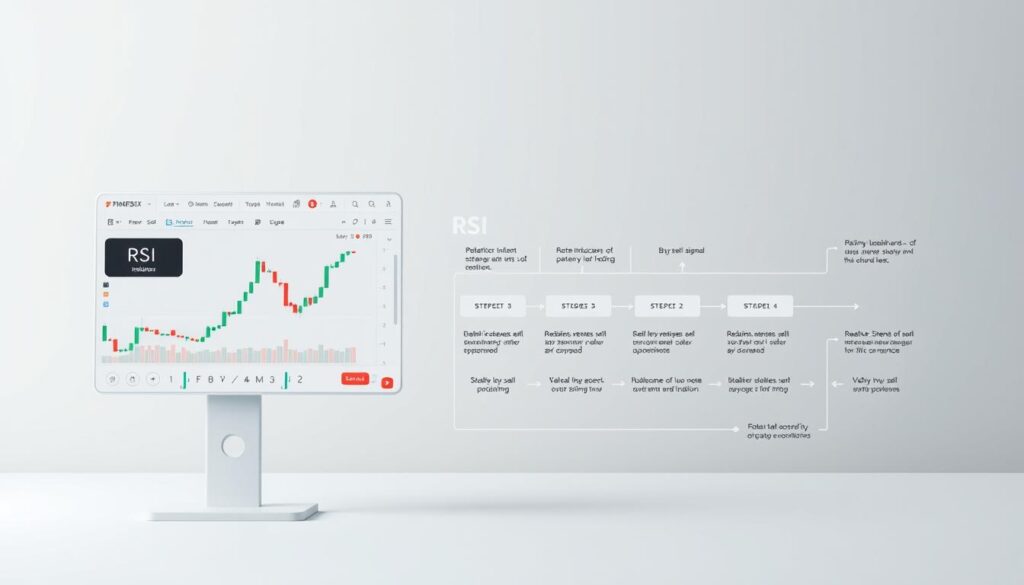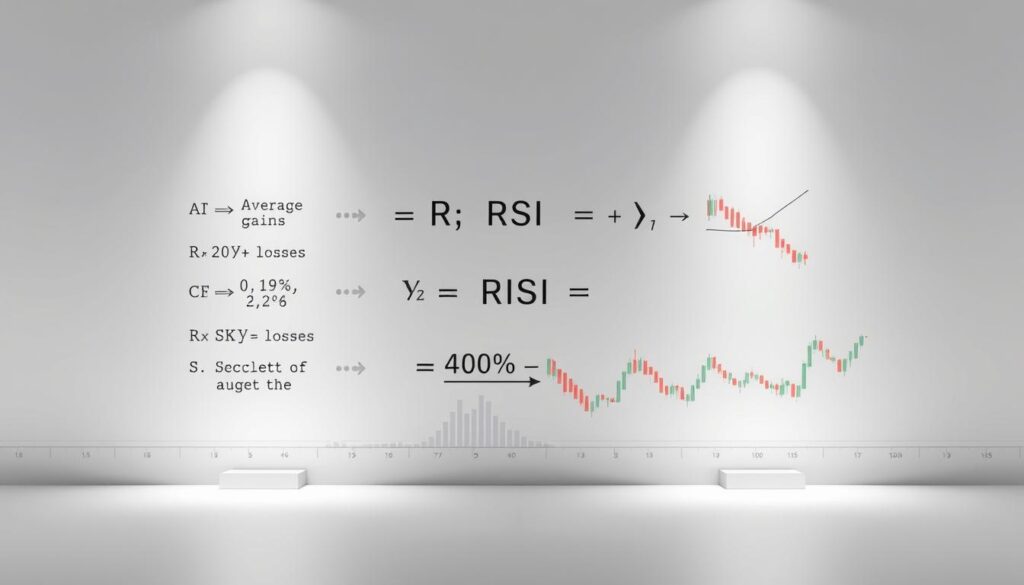Now Reading: Using Relative Strength Index RSI Crypto Strategy for Better Trades
- 01
Using Relative Strength Index RSI Crypto Strategy for Better Trades
Using Relative Strength Index RSI Crypto Strategy for Better Trades

Making smart decisions in the fast-moving world of digital assets requires reliable tools. This guide introduces a powerful method for analyzing price action. It helps traders spot potential opportunities with greater confidence.
The relative strength index is a popular momentum oscillator. It measures the speed and change of price movements. This tool gives clear signals about market conditions.
Understanding this indicator can significantly improve your timing. It helps identify when an asset might be overbought or oversold. This knowledge is crucial for managing risk in volatile markets.
We will explore practical applications and calculation methods. You will see real-world examples of how this approach works. Both new and experienced traders can benefit from these insights.
Mastering this technique provides an objective framework for your actions. It reduces emotional decision-making by relying on data. This leads to more disciplined and potentially more profitable outcomes.
Key Takeaways
- The RSI is a momentum indicator that measures the speed of price changes.
- It helps identify potential overbought and oversold market conditions.
- Using this tool can improve entry and exit timing for trades.
- It provides data-driven signals to help avoid emotional decisions.
- This guide covers practical applications for traders at all levels.
- Understanding momentum is key to navigating volatile markets.
Introduction to the Role of RSI in Crypto Trading
Understanding the underlying force behind price swings is a cornerstone of effective digital asset trading. This momentum oscillator has been a trusted tool for decades. Its principles are now vital for navigating modern, 24-hour markets.
Background and Relevance
Originally developed for stock market analysis, this indicator’s logic translates perfectly to digital assets. It measures the pace of recent price changes. This gives a clear picture of buying and selling pressure.
The tool remains relevant because it provides objective data. It helps distinguish between sustainable trends and short-lived fluctuations. This is especially useful in fast-moving environments.
How RSI Provides Market Momentum Insights
Think of this oscillator as a speedometer for market activity. It calculates the speed and direction of price moves. This offers an advance warning of potential trend changes.
Traders gain critical insights into whether a current move is likely to continue or reverse. This type of analysis is invaluable when sentiment can shift rapidly. It adds a layer of confidence to decision-making.
What is the Relative Strength Index (RSI)?
Technical analysts rely on a powerful gauge that transforms raw price data into actionable insights about market momentum and potential turning points. This tool has become essential for traders seeking objective measurements of price movement intensity.
Definition and History
The relative strength index functions as a momentum oscillator. It calculates the velocity and magnitude of recent price changes. J. Welles Wilder Jr. introduced this innovative approach in his 1978 publication.
His book “New Concepts in Technical Trading Systems” presented the RSI formula. This breakthrough provided traders with a normalized scale from 0 to 100. The visual display typically appears below main price charts.
Key Technical Analysis Concepts
This indicator compares upward and downward price movement strength. It focuses on change velocity rather than absolute price levels. This distinction makes the strength index uniquely valuable.
The RSI remains popular across different market types. Its simplicity and proven effectiveness contribute to enduring relevance. Modern traders continue applying these technical analysis principles successfully.
Core Concepts: Overbought, Oversold, and Divergence
Three critical concepts form the foundation of interpreting momentum oscillator readings accurately. These elements help traders identify potential turning points in market trends.
Understanding Overbought and Oversold Conditions
When the indicator rises above 70, it suggests overbought conditions. This means prices may be overvalued and due for a decline.
Conversely, readings below 30 indicate oversold conditions. The asset might be undervalued and ready for upward movement.
These levels serve as warning zones rather than direct action triggers. Always confirm with additional market data before making decisions.
Recognizing Bullish and Bearish Divergence
Bullish divergence occurs when price makes lower lows while the indicator forms higher lows. This shows weakening downward momentum despite falling prices.
Bearish divergence appears when price reaches higher highs but the indicator creates lower highs. This signals fading upward momentum during price increases.
Divergence patterns provide early warnings about potential trend changes. They often appear before reversals become obvious on price charts.
Mastering the relative strength index RSI crypto strategy
Translating technical signals into profitable actions separates successful traders from the crowd. This methodology provides a structured framework for decision-making. It helps transform raw data into clear execution plans.
Strategy Overview and Principles
The core philosophy revolves around identifying momentum shifts. Traders aim to capitalize on overbought and oversold conditions. This approach emphasizes patience over impulsive reactions.
Instead of acting immediately when levels hit extremes, wait for confirmation. A better tactic involves watching for the indicator to cross back from these zones. This signals a genuine change in market pressure.

When to Enter and Exit Trades
Consider entry positions after the oscillator moves back above 30 from oversold territory. This suggests buying pressure is returning. Similarly, exit considerations arise when it crosses below 70 from overbought levels.
These cross-back signals often provide more reliable trade triggers. They help lock in profits before major reversals occur. Combining these signs with other market data significantly improves accuracy.
Avoid the common error of buying or selling at the exact moment extremes are touched. The most effective plans incorporate risk management and multiple timeframe analysis. This creates a robust system for navigating various market conditions.
RSI in Swing Trading: Leveraging Short-Term Price Movements
The art of swing trading lies in recognizing when momentum shifts create profitable entry and exit points. This approach captures gains from intermediate price oscillations that occur between major trend changes.
Swing traders often use the momentum oscillator to time their positions effectively. A common method involves buying when the indicator crosses below 30 and selling when it moves above 70. This cycle repeats as markets oscillate between extremes.
Identifying Key Support and Resistance Levels
The oscillator can reveal important price zones before they become visible on standard charts. Support represents areas where buying pressure prevents further declines. Resistance marks levels where selling pressure halts upward movement.
When combined with traditional chart analysis, these zones become more reliable. The indicator itself can also act as dynamic support and resistance during different market conditions.
| RSI Level | Trading Significance | Price Action |
|---|---|---|
| Below 30 | Potential buying opportunity | Oversold conditions |
| 30-70 Range | Neutral territory | Normal market fluctuations |
| Above 70 | Potential selling opportunity | Overbought conditions |
| 40-50 (Uptrend) | Dynamic support | Buying pressure zone |
| 50-60 (Downtrend) | Dynamic resistance | Selling pressure zone |
This combination helps traders anticipate where price reversals might occur. It improves timing for both entry and exit decisions in swing trading approaches.
Step-by-Step Guide: Calculating the RSI
Understanding the computational mechanics of technical indicators transforms them from black boxes into trusted allies. This section reveals the mathematical foundation behind the momentum oscillator’s calculations.
RSI Formula Breakdown
The core formula follows a straightforward structure: RSI = 100 – [100 / (1 + RS)]. The RS component represents the ratio of average gain to average loss over a specified timeframe.
This calculation begins by determining price changes across a chosen period. Typically, analysts use 14 periods as the standard setting. The formula then compares upward and downward movement strength.

Smoothing Techniques and Period Selection
Wilder’s smoothing method enhances result stability. It incorporates previous averages with current data using a weighted approach. This prevents extreme readings during normal market conditions.
Traders can adjust the period setting based on their needs. Shorter periods increase sensitivity to recent price action. Longer periods provide smoother, more stable readings.
| Calculation Component | Purpose | Standard Value |
|---|---|---|
| Look-back Period | Data sample size | 14 periods |
| Average Gain | Measure upward momentum | Mean of positive changes |
| Average Loss | Measure downward pressure | Mean of negative changes |
| RS Ratio | Compare gain/loss strength | Gain ÷ Loss |
| Smoothing Factor | Stabilize readings | Wilder’s method |
Interpreting RSI Signals for Trend Confirmation
The centerline crossing at 50 serves as a critical threshold for determining the dominant market force. When this momentum oscillator moves above 50, it suggests bullish control. A drop below this level indicates bearish pressure.
This simple division helps traders understand the overall market direction. It provides valuable context for interpreting other technical signals.
Bullish vs. Bearish Signals
During uptrends, the indicator typically ranges between 40 and 90. The 40-50 zone often acts as dynamic support. A bounce from this area confirms the upward trend.
Bearish conditions show the opposite pattern. The oscillator usually stays between 10 and 60 during downtrends. The 50-60 range frequently serves as resistance.
These characteristic ranges help distinguish between trending and ranging markets. Signals that align with the prevailing trend tend to be more reliable.
Traders gain better confirmation when multiple factors support the same conclusion. This approach reduces false signals and improves decision accuracy.
Optimizing RSI Settings for Different Market Conditions
The most successful traders adapt their analytical tools rather than using rigid default settings. Customizing parameters helps match your trading style and current market behavior.
Standard configurations work well for general analysis. However, specific situations often benefit from tailored adjustments.
Adjusting Time Periods for Sensitivity
The traditional 14-period setting provides balanced responsiveness. Shorter periods like 7 or 9 increase sensitivity to recent price changes.
Longer periods such as 21 or 30 create smoother readings. They focus on stronger momentum shifts while reducing market noise.
Modifying Overbought and Oversold Levels
The standard 70/30 thresholds serve as guidelines, not strict rules. Volatile markets might require raising overbought levels to 80 or 90.
Calmer conditions could benefit from lowering oversold levels to 20 or 10. This helps identify reversal opportunities earlier. Learn more about customizing these parameters for better results.
| Market Condition | Recommended Period | Overbought Level | Oversold Level |
|---|---|---|---|
| High Volatility | 21-30 | 80-90 | 20-25 |
| Normal Fluctuation | 14 (default) | 70 | 30 |
| Low Volatility | 7-9 | 60-65 | 10-15 |
| Strong Bull Market | 14-21 | 85-90 | 35-40 |
| Bear Market | 14-21 | 55-60 | 10-15 |
Testing different settings using historical data helps identify optimal configurations. The right parameters can significantly improve signal accuracy across various market environments.
Comparing RSI with Other Technical Indicators
Smart traders often use multiple analytical tools to confirm their market views. This approach helps reduce false signals and improves decision accuracy. Understanding how different indicators complement each other creates a more robust framework.
RSI Versus MACD: Strengths and Differences
The MACD tracks the relationship between two exponential moving averages. It focuses on trend direction and momentum shifts between these averages. This makes it excellent for identifying trend changes.
Meanwhile, the RSI indicator measures price change momentum against recent highs and lows. It provides clear overbought and oversold signals within a bounded 0-100 scale. These tools measure momentum but approach it differently.
Sometimes these indicators give contradictory signals. An asset might show overbought conditions on the RSI while MACD suggests continuing upward momentum. Understanding these differences helps traders interpret conflicting data.
Integrating Multiple Indicators for Better Decisions
Successful technical analysis typically combines several complementary tools. Many traders use RSI for timing entries and exits. They then confirm the overall trend direction with moving averages or trendlines.
Volume analysis and support/resistance levels add further confirmation. This multi-layered approach creates more reliable trading strategies. Each indicator serves as one component in a comprehensive system.
Developing a framework for integrating signals improves decision-making accuracy. The goal is creating a balanced methodology that reduces reliance on any single tool.
Common Pitfalls and Risk Management with RSI Trading
Even the most reliable technical tools have inherent limitations that require careful management. Understanding these boundaries helps traders avoid costly mistakes and develop more robust approaches.
The standard 30 and 70 levels don’t always provide accurate signals. During strong trends, prices can continue moving while the indicator stays in extreme zones. This creates false readings that can mislead unprepared traders.

Avoiding False Signals and Overtrading
False positives occur when bullish crossovers immediately reverse into declines. The momentum-based nature of this tool means it can remain overbought or oversold during sustained moves. This is particularly challenging in trending markets.
Many traders fall into the trap of overtrading based solely on these signals. They treat the standard levels as absolute rules rather than flexible guidelines. This approach often leads to premature entries and exits.
The indicator performs best in oscillating markets where prices alternate between movements. During strong directional trends, additional confirmation becomes essential. Combining multiple analysis methods reduces false signal risks.
Effective risk management strategies include using stop-loss orders and proper position sizing. Avoid trades that contradict the prevailing market direction. Discipline remains crucial when signals don’t perform as expected.
Utilizing Charting Tools and Platforms for Effective RSI Analysis
The accessibility of professional charting tools has leveled the playing field for traders of all experience levels. Modern platforms handle complex calculations automatically, allowing users to focus on interpretation rather than computation.
Most trading software displays the momentum oscillator as a line moving between 0 and 100. Horizontal reference lines typically mark the 30 and 70 levels for quick visual reference.
Top Platforms and Tools for Crypto Traders
TradingView stands out as a popular choice among market participants. This platform offers comprehensive charting capabilities with automatic indicator calculations.
The tool appears in a separate panel beneath the main price chart. This layout makes it easy to correlate momentum changes with price movements.
Professional-grade platforms allow extensive customization of settings. Users can adjust period length, overbought/oversold levels, and visual appearance.
Advanced features include drawing trendlines directly on the oscillator display. Alert systems notify traders when specific levels are reached.
These platforms integrate multiple technical indicators for comprehensive market analysis. The combination of tools provides stronger confirmation signals for trading decisions.
Practical Examples: RSI Strategies in Live Crypto Markets
Concrete examples transform abstract technical concepts into practical decision-making frameworks. This section demonstrates how traders apply momentum signals in various market conditions.

Case Studies of Successful RSI Trades
One trader identified an opportunity when the indicator dropped below 30 during a temporary sell-off. They entered a long position as buying pressure returned.
The position became profitable when the momentum oscillator crossed back above 30. This confirmed the reversal was genuine.
Another example shows a profitable exit when the tool reached overbought territory above 70. The trader closed their position before the subsequent decline.
| Market Condition | Signal Used | Result |
|---|---|---|
| Range-bound Market | Oscillator below 30 | Successful long entry |
| Strong Uptrend | Divergence pattern | Early exit before reversal |
| High Volatility | Custom levels (20/80) | Reduced false signals |
| Consolidation Phase | Centerline crossover | Accurate trend identification |
Real-World Application and Trade Setups
Bullish divergence setups occur when price makes lower lows while the momentum indicator forms higher lows. This signals weakening selling pressure.
Traders often combine this pattern with oversold readings for stronger confirmation. The convergence of signals increases confidence in the trade setup.
Bearish divergence appears during price increases when the tool creates lower highs. This warns of potential trend exhaustion before it becomes visible on price charts alone.
These real-world applications show how to use momentum analysis effectively across different assets and timeframes.
Conclusion
Effective market navigation relies on combining objective data signals with disciplined execution principles. The momentum indicator discussed throughout this guide serves as a powerful tool for traders seeking clearer market insights.
Mastering this approach requires practice and patience. It works best when integrated with other analytical methods and proper risk management. Successful application involves adapting settings to match specific conditions.
Continuous learning remains essential for improving skills. Backtesting and gradual implementation help build confidence. This trading tool becomes most effective when combined with experience and sound decision-making.
FAQ
What is the main purpose of the RSI indicator?
The main purpose is to measure the speed and change of price movements. It helps traders identify when an asset might be overbought or oversold, signaling potential trend reversals.
How do I know if a market is overbought or oversold using this tool?
Traditionally, a reading above 70 suggests an overbought condition, meaning the asset may be overvalued. A reading below 30 indicates an oversold condition, suggesting it may be undervalued and due for a bounce.
What is divergence and why is it important?
Divergence occurs when the price of an asset moves in the opposite direction of the indicator. For example, if the price makes a new high but the indicator makes a lower high, it’s a bearish signal that the uptrend may be weakening.
Can I use this tool for all types of trading, like day trading or swing trading?
Yes, it is versatile. Day traders might use shorter time periods for quick signals, while swing traders often use standard settings to capture moves over several days or weeks. The strategy adapts to different timeframes.
What is a common mistake traders make when using this momentum oscillator?
A common pitfall is acting on signals from overbought or oversold zones during a very strong trend. In powerful bull or bear markets, the indicator can stay in extreme territories for extended periods, leading to false signals if used alone.
Should I use this tool by itself or with other analysis methods?
It is best used with other forms of confirmation. Combining it with tools like moving averages or support and resistance levels can provide stronger, more reliable trade signals and improve decision-making.
How do I calculate the values for this indicator?
The calculation involves a formula that compares the average gains and losses over a selected period, typically 14 days. Most modern charting platforms perform this calculation automatically, allowing you to focus on interpretation.
Where can I find this technical analysis tool?
Nearly all major trading and charting platforms, such as TradingView, Coinbase Advanced Trade, and Binance, include it as a standard feature in their technical analysis toolkit.















